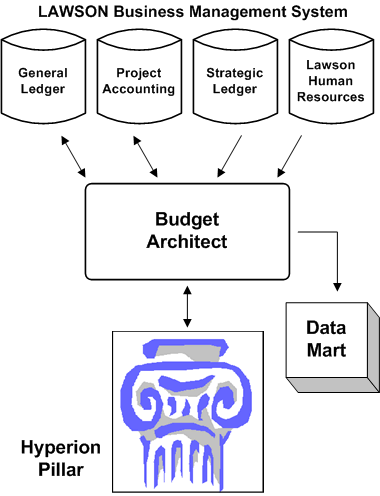Budget Architect overview
The Budget Architect application provides data transfer capabilities between your budget application and your Lawson Business Management System (BMS) databases.
For example, if you use the Hyperion Pillar® application, then you can use Budget Architect to transfer your budget data to the Pillar application from your General Ledger, Project Accounting, Strategic Ledger, and Lawson Human Resources applications.
Budget administrators use the Pillar application to create a main budget plan and distribute the appropriate budgets to planners within the organization such as department managers, project supervisors, and team leads.
In the Pillar application, these individuals, or planners, create their budget plans. The budgets are consolidated by the budget administrator and exported back to Lawson General Ledger and Project Accounting.
This diagram shows the Lawson Business Management System overview:

You can also use the Budget Architect to transfer data from your budget application to a multidimensional database, or data mart, that you create using the Lawson Analytic Architect. You can export budgets to the Financial, Project, Strategic Ledger, and Employee Compensation data mart.
See Analytic Architect User Guide.
Budget Architect takes the budget application's perspective when using the terms import and export. For example, if you use the Hyperion Pillar application, then importing refers to the process of transferring data from Lawson to the Pillar application. Exporting refers to the process of transferring budgets from the Pillar application to Lawson.
You can use the Budget Architect application to enable a budget administrator to interface information from Lawson's Business Management System to a budget application such as Hyperion Solutions Pillar application. Budget Architect can bring budget data from the budget application back to the Lawson Business Management System.
This diagram shows the primary steps in the enterprise budgeting process: